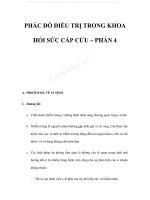Ứng dụng thực tiễn trong khoa hồi sức sơ sinh_Tiếng Anh
Bạn đang xem bản rút gọn của tài liệu. Xem và tải ngay bản đầy đủ của tài liệu tại đây (603 KB, 31 trang )
<span class='text_page_counter'>(1)</span><div class='page_container' data-page=1>
Developmental Care
</div>
<span class='text_page_counter'>(2)</span><div class='page_container' data-page=2>
Key messages
• Preterm infants are born prior to or during
critical periods of brain development.
• Developmental care aims to reduce stress on
infants and promote neurological development.
• Simple, easy to implement modifications to the
nursery environment and care practices may help
reduce morbidity.
• Attention to noise, light and position of neonates
can all help to reduce stress and maximise
</div>
<span class='text_page_counter'>(3)</span><div class='page_container' data-page=3>
Definition of Developmental care
The process of developmental care involves
creating an environment for the infant that
minimises stress while providing a
</div>
<span class='text_page_counter'>(4)</span><div class='page_container' data-page=4>
Goals of developmental care - Infant
• reduce stress
• conserve energy and enhance recovery
• promote growth and well being
</div>
<span class='text_page_counter'>(5)</span><div class='page_container' data-page=5>
Goals of developmental care - Family
• encourage and support parents in the
primary caregiver role
</div>
<span class='text_page_counter'>(6)</span><div class='page_container' data-page=6>
Developmental care refers to
interventions that:
• support the behavioural organisation of
the individual infant
• enhance physiological stability
• protect sleep rhythms
</div>
<span class='text_page_counter'>(7)</span><div class='page_container' data-page=7>
Developmental care interventions
include:
• optimal handling and positioning
measures
• reduction of noxious environmental
stimuli
</div>
<span class='text_page_counter'>(8)</span><div class='page_container' data-page=8>
Behavioural organisation
This refers to the ability of the infant to
maintain a balance between the five
subsystems:
• autonomic/physiologic
• motor
• state organisation
• attention / interaction
</div>
<span class='text_page_counter'>(9)</span><div class='page_container' data-page=9>
Behavioural organisation
Examples would include the infant's respiratory
status, muscle tone, posture, facial
expressions, colour, visceral responses and
visual attention.
How these behaviours are affected by external
stimuli, either positive or negative, give
</div>
<span class='text_page_counter'>(10)</span><div class='page_container' data-page=10>
Cue based care
</div>
<span class='text_page_counter'>(11)</span><div class='page_container' data-page=11>
Implementation of developmental
care
Assessment includes the:
Nursery environment - including the acoustic
environment, aspects of lighting, general layout and
furnishings.
Infants - including regular review and modification
depending on:
• condition of the infant
• infant's level of maturity and gestational age
</div>
<span class='text_page_counter'>(12)</span><div class='page_container' data-page=12>
Noise effects
The threshold for cochlear damage for adults
is 80-85 decibels and the newborn will have a
lower threshold than this as the immature
cochlear is more sensitive. In the nursery
noises of this magnitude include closing
portholes with a snap or placing bottles on the
top of the plexiglass incubator.
Sound level recommendations for the nursery
environment (Aus. and NZ guidelines)
</div>
<span class='text_page_counter'>(13)</span><div class='page_container' data-page=13>
Noise reduction tips
Implement these interventions to reduce noise:
• Turn radio volume down or off.
• Have designated quiet times during the day (while
also remembering to keep to limits at all times).
• Close incubator portholes quietly.
• Encourage staff and visitors to talk quietly, and
avoid talking over the infant in an open cot
• Avoid banging bin lids
• Set monitor alarm limits and tone at appropriate
levels and try to silence alarms as soon as possible
</div>
<span class='text_page_counter'>(14)</span><div class='page_container' data-page=14>
Light
Lighting should be adjustable - the adjustment
level range of 100-600 lux is recommended
(Aus. and NZ guidelines).
</div>
<span class='text_page_counter'>(15)</span><div class='page_container' data-page=15>
Light
Lighting should be adjustable - the adjustment
level range of 100-600 lux is recommended
(Aus. and NZ guidelines).
</div>
<span class='text_page_counter'>(16)</span><div class='page_container' data-page=16>
Light
Interventions to maintain an appropriate
individualised light environment include:
• Use adjustable light levels within each cot bay
plus procedure light for observation and
procedures.
• Monitor ambient light levels.
• Shield infants from bright light with cot covers,
eye covers and dimmed lights.
</div>
<span class='text_page_counter'>(17)</span><div class='page_container' data-page=17>
Positioning
Infants should be positioned with:
• symmetrical postures
• trunk flexion, shoulder and hip
flexion and adduction
• shoulder protraction, hands near
face
• neutral alignment of ankles and hips
• neutral alignment of head and neck
whenever possible
</div>
<span class='text_page_counter'>(18)</span><div class='page_container' data-page=18>
Parental involvement
<b>Parents are involved in decisions </b>
<b>about interventions where possible. </b>
This promotes their understanding of
</div>
<span class='text_page_counter'>(19)</span><div class='page_container' data-page=19>
Parental involvement
This allows them to experience positive
</div>
<span class='text_page_counter'>(20)</span><div class='page_container' data-page=20>
Nursery practices
Cue based care and clustering of care
• This involves caring for the infant while
recognising the behavioural cues or stress
responses and providing an appropriate
strategy such as timeout or modification of
care as appropriate.
• Clustering of cares encourages a
</div>
<span class='text_page_counter'>(21)</span><div class='page_container' data-page=21>
Nursery practices
Cue based care and clustering of care
If an infant is unable to cope with a particular
cluster of care (observation of stress cues)
</div>
<span class='text_page_counter'>(22)</span><div class='page_container' data-page=22>
Stressful or painful procedures
Minimise painful procedures and provide
appropriate pain relief measures.
</div>
<span class='text_page_counter'>(23)</span><div class='page_container' data-page=23>
Stressful or painful procedures
Comforting techniques include:
• non-nutritive sucking
(dummy, cotton bud with
breast milk or sucrose)
• containment of infant's
arms and or legs (swaddle or
gently holding hands
together on chest and/or
hold legs tucked up)
</div>
<span class='text_page_counter'>(24)</span><div class='page_container' data-page=24>
Feeding support
Provide support for
breastfeeding or alternatives
as required with the
emphasis again on
individualised family centred
care.
Follow the infant's cues and
pace the feeds, according to
the infant’s capacity to
organise sucking,
</div>
<span class='text_page_counter'>(25)</span><div class='page_container' data-page=25>
Non-nutritive sucking
Offer the infant opportunities to suck on a dummy or
other suitable object, such as a finger, own hands or
a suitable toy.
</div>
<span class='text_page_counter'>(26)</span><div class='page_container' data-page=26>
Staffing practices
Provide continuity of caregivers whenever
</div>
<span class='text_page_counter'>(27)</span><div class='page_container' data-page=27>
Handling techniques include:
• Handle infants in ways that minimise stress and
uncontrolled responses.
• Contain the infant using hands or a light
swaddle to keep them in a flexed and contained
position.
• Move infant slowly and keep them in contact
with the supporting surface whenever possible.
• Introduce touch slowly and allow time for the
infant to respond and adjust to a change in
</div>
<span class='text_page_counter'>(28)</span><div class='page_container' data-page=28>
Noxious stimuli
Minimize the infant’s exposure to noxious
stimuli such as strong fragrances, open alcohol
swabs outside the incubator, clinical
</div>
<span class='text_page_counter'>(29)</span><div class='page_container' data-page=29>
Kangaroo care
Provide opportunities for kangaroo
</div>
<span class='text_page_counter'>(30)</span><div class='page_container' data-page=30>
Kangaroo care has been shown to:
• Improve state organisation.
• Reduce oxygen needs, improve respiratory
patterns.
• Reduce apnoea’s and bradycardias.
• Improve thermal regulation.
• Enhance parent infant bonding and a parental
sense of competence.
</div>
<span class='text_page_counter'>(31)</span><div class='page_container' data-page=31>
Reference
<b>Neonatal e-handbook: developmental care </b>
<b>for neonates</b>
</div>
<!--links-->
PHÁC ĐỒ ĐIỀU TRỊ TRONG KHOA HỒI SỨC CẤP CỨU – PHẦN 4 ppt
- 16
- 833
- 2








